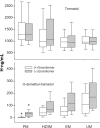Pharmacogenomic considerations in opioid analgesia
- PMID: 23226064
- PMCID: PMC3513230
- DOI: 10.2147/PGPM.S23422
Pharmacogenomic considerations in opioid analgesia
Erratum in
- Pharmgenomics Pers Med. 2013;6:1
Abstract
Translating pharmacogenetics to clinical practice has been particularly challenging in the context of pain, due to the complexity of this multifaceted phenotype and the overall subjective nature of pain perception and response to analgesia. Overall, numerous genes involved with the pharmacokinetics and dynamics of opioids response are candidate genes in the context of opioid analgesia. The clinical relevance of CYP2D6 genotyping to predict analgesic outcomes is still relatively unknown; the two extremes in CYP2D6 genotype (ultrarapid and poor metabolism) seem to predict pain response and/or adverse effects. Overall, the level of evidence linking genetic variability (CYP2D6 and CYP3A4) to oxycodone response and phenotype (altered biotransformation of oxycodone into oxymorphone and overall clearance of oxycodone and oxymorphone) is strong; however, there has been no randomized clinical trial on the benefits of genetic testing prior to oxycodone therapy. On the other hand, predicting the analgesic response to morphine based on pharmacogenetic testing is more complex; though there was hope that simple genetic testing would allow tailoring morphine doses to provide optimal analgesia, this is unlikely to occur. A variety of polymorphisms clearly influence pain perception and behavior in response to pain. However, the response to analgesics also differs depending on the pain modality and the potential for repeated noxious stimuli, the opioid prescribed, and even its route of administration.
Keywords: genetic variation; opioid analgesia; pain perception; pharmacogenetics.
Figures


Similar articles
-
Does co-administration of paroxetine change oxycodone analgesia: An interaction study in chronic pain patients.Scand J Pain. 2010 Jan 1;1(1):24-33. doi: 10.1016/j.sjpain.2009.09.003. Scand J Pain. 2010. PMID: 29913934
-
Contribution of CYP2D6 Functional Activity to Oxycodone Efficacy in Pain Management: Genetic Polymorphisms, Phenoconversion, and Tissue-Selective Metabolism.Pharmaceutics. 2021 Sep 14;13(9):1466. doi: 10.3390/pharmaceutics13091466. Pharmaceutics. 2021. PMID: 34575542 Free PMC article. Review.
-
Impact of CYP2D6 Pharmacogenomic Status on Pain Control Among Opioid-Treated Oncology Patients.Oncologist. 2021 Nov;26(11):e2042-e2052. doi: 10.1002/onco.13953. Epub 2021 Sep 19. Oncologist. 2021. PMID: 34423496 Free PMC article.
-
CYP2D6 pharmacogenetic and oxycodone pharmacokinetic association study in pediatric surgical patients.Pharmacogenomics. 2017 Mar;18(4):337-348. doi: 10.2217/pgs-2016-0183. Epub 2017 Feb 17. Pharmacogenomics. 2017. PMID: 28244808 Free PMC article. Clinical Trial.
-
Oxycodone Therapy and CYP2D6 Genotype.2022 Oct 4 [updated 2025 Apr 14]. In: Pratt VM, Scott SA, Pirmohamed M, Esquivel B, Kattman BL, Malheiro AJ, editors. Medical Genetics Summaries [Internet]. Bethesda (MD): National Center for Biotechnology Information (US); 2012–. 2022 Oct 4 [updated 2025 Apr 14]. In: Pratt VM, Scott SA, Pirmohamed M, Esquivel B, Kattman BL, Malheiro AJ, editors. Medical Genetics Summaries [Internet]. Bethesda (MD): National Center for Biotechnology Information (US); 2012–. PMID: 36198024 Free Books & Documents. Review.
Cited by
-
Genome-Wide Association Study Identifies Candidate Loci Associated with Opioid Analgesic Requirements in the Treatment of Cancer Pain.Cancers (Basel). 2022 Sep 27;14(19):4692. doi: 10.3390/cancers14194692. Cancers (Basel). 2022. PMID: 36230616 Free PMC article.
-
Associations between the C3orf20 rs12496846 Polymorphism and Both Postoperative Analgesia after Orthognathic and Abdominal Surgeries and C3orf20 Gene Expression in the Brain.Pharmaceutics. 2022 Mar 28;14(4):727. doi: 10.3390/pharmaceutics14040727. Pharmaceutics. 2022. PMID: 35456561 Free PMC article.
-
A pharmacogenetics approach to pain management.Neuropsychopharmacol Rep. 2018 Mar;38(1):2-8. doi: 10.1002/npr2.12003. Epub 2018 Feb 6. Neuropsychopharmacol Rep. 2018. PMID: 30106264 Free PMC article. Review.
-
Genome-Wide Association Study Identifies Genetic Polymorphisms Associated with Estimated Minimum Effective Concentration of Fentanyl in Patients Undergoing Laparoscopic-Assisted Colectomy.Int J Mol Sci. 2023 May 8;24(9):8421. doi: 10.3390/ijms24098421. Int J Mol Sci. 2023. PMID: 37176129 Free PMC article.
-
Impact of Pharmacogenomic Information on Values of Care and Quality of Life Associated with Codeine and Tramadol-Related Adverse Drug Events.Mayo Clin Proc Innov Qual Outcomes. 2021 Jan 13;5(1):35-45. doi: 10.1016/j.mayocpiqo.2020.08.009. eCollection 2021 Feb. Mayo Clin Proc Innov Qual Outcomes. 2021. PMID: 33718782 Free PMC article.
References
-
- Frueh FW, Amur S, Mummaneni P, et al. Pharmacogenomic biomarker information in drug labels approved by the United States food and drug administration: prevalence of related drug use. Pharmacotherapy. 2008;28:992–998. - PubMed
-
- Sim SC, Ingelman-Sundberg M. Pharmacogenomic biomarkers: new tools in current and future drug therapy. Trends Pharmacol Sci. 2011;32:72–81. - PubMed
LinkOut - more resources
Full Text Sources
Other Literature Sources

